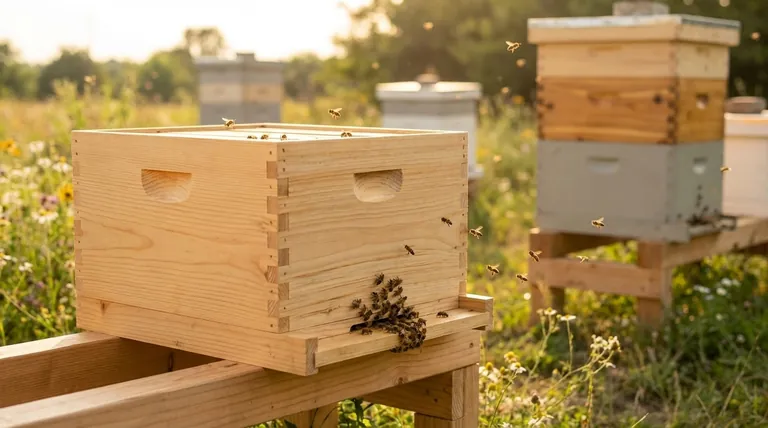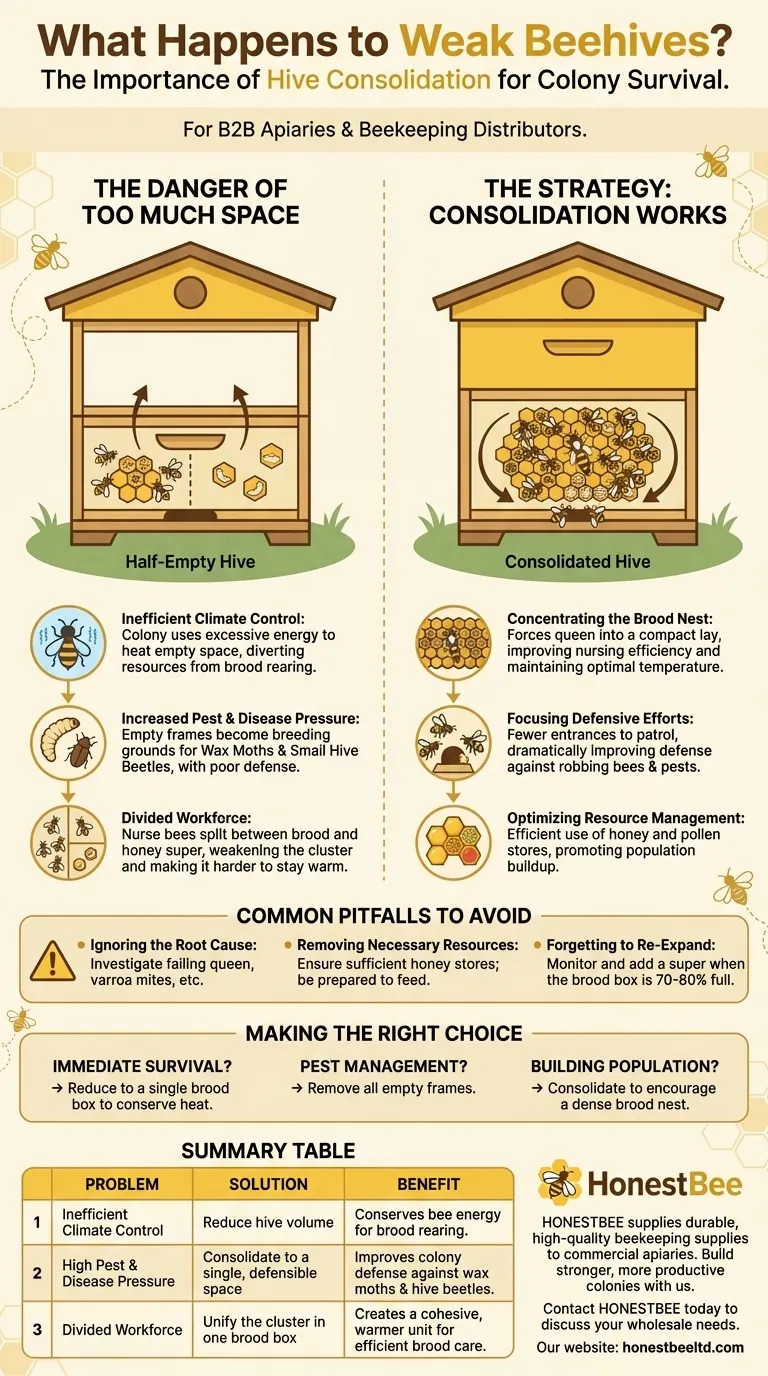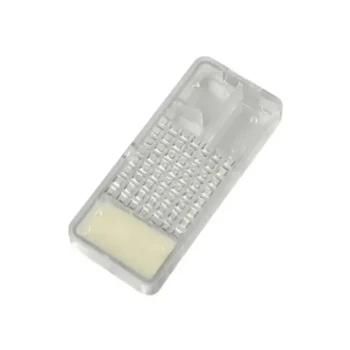In short, a beehive that is not strong enough to occupy both a brood box and a honey super is typically reduced to a single brood box. This strategic consolidation is a critical management technique designed to help a weaker colony survive, recover, and eventually thrive by concentrating its resources and efforts into a smaller, more defensible space.
The core principle is simple: forcing a small colony to manage a large space is inefficient and dangerous. By reducing the hive's volume, you allow the bees to focus their energy on the two most critical tasks: raising brood and defending the colony.

The Danger of Too Much Space
A common mistake for new beekeepers is assuming that more space is always better. For a weak or developing colony, excess space is a liability that can lead to a cascade of problems.
Inefficient Climate Control
A bee colony must maintain the brood nest at a consistent temperature (around 95°F or 35°C). In a large, half-empty hive, the bees must expend enormous amounts of energy to generate heat, diverting resources that would otherwise be used for foraging and raising young.
Increased Pest and Disease Pressure
A small population of bees cannot effectively patrol a large territory. Unused frames and empty corners become ideal breeding grounds for pests like wax moths and small hive beetles. The colony's inability to defend this extra space makes it highly vulnerable.
Divided Workforce and a "Stuck" Cluster
If the queen has laid eggs in the honey super, the problem is compounded. Nurse bees are obligated to stay with the brood to care for it. This can split the colony's cluster between two boxes, weakening their ability to stay warm and function as a cohesive unit.
The Strategy: Why Consolidation Works
Reducing a weak hive to a single box is a proactive measure to reverse these negative factors. It creates a high-density environment that plays to the colony's strengths.
Concentrating the Brood Nest
Removing the honey super forces the queen and all nurse bees down into the brood box. This encourages the queen to lay in a more compact pattern, making it far more efficient for the nurse bees to feed larvae and maintain the correct temperature.
Focusing Defensive Efforts
With less territory to patrol, the guard bees can focus their attention on a single entrance. This dramatically improves their ability to repel robbing bees from other colonies and defend against pests.
Optimizing Resource Management
By living in a smaller, more densely populated space, the bees can manage their honey and pollen stores more effectively. This ensures the colony has the resources it needs to build up its population without wasting energy.
Common Pitfalls to Avoid
While consolidation is a powerful technique, it must be done with an understanding of the potential consequences.
Ignoring the Root Cause
Reducing the hive's size treats a symptom, not the underlying disease. You must still investigate why the colony is weak. Common causes include a failing queen, a high varroa mite load, or other diseases.
Removing Necessary Resources
When you remove the super, be careful not to remove a significant amount of the colony's stored honey. If the hive is low on food, you must be prepared to feed them, especially if there is no natural nectar flow.
Forgetting to Re-Expand
Consolidation is a temporary measure. If the technique is successful, the colony will grow. You must monitor their progress and be ready to add a super back on once they have filled 70-80% of the frames in the brood box to prevent them from swarming.
Making the Right Choice for Your Hive
Your decision should be based on a clear assessment of the colony's strength and your ultimate goal for its development.
- If your primary focus is immediate survival: Reduce the hive to a single brood box to conserve heat and help the bees defend themselves.
- If your primary focus is pest management: Remove all empty or sparsely populated frames, as these are prime targets for infestation.
- If your primary focus is building population: Consolidate the hive to encourage a dense brood nest, which is the most efficient way for the colony to raise new bees.
Properly managing a hive's space is one of the most fundamental skills in beekeeping.
Summary Table:
| Problem | Solution | Benefit |
|---|---|---|
| Inefficient Climate Control | Reduce hive volume | Conserves bee energy for brood rearing |
| High Pest & Disease Pressure | Consolidate to a single, defensible space | Improves colony defense against wax moths & hive beetles |
| Divided Workforce | Unify the cluster in one brood box | Creates a cohesive, warmer unit for efficient brood care |
Is your apiary struggling with weak hives? Proper equipment is key to effective hive management. HONESTBEE supplies durable, high-quality beekeeping supplies and equipment to commercial apiaries and beekeeping equipment distributors through our wholesale-focused operations. Let us help you build stronger, more productive colonies. Contact HONESTBEE today to discuss your wholesale needs.
Visual Guide

Related Products
- Langstroth Honey Bee Box Hive Boxes for Different Depths
- Portable Bee Mating Hive Boxes Mini Mating Nucs 8 Frames for Queen Rearing
- Australian Langstroth Beehive Boxes for Beekeeping Wholesales
- Twin Queen Styrofoam Honey Bee Nucs Mating and Breeding Box
- Automatic Heat Preservation 6 Frame Pro Nuc Box for Honey Bee Queen Mating
People Also Ask
- How is checking honey supers in a Langstroth hive different from inspecting Honey Flow supers? A Guide to Disruptive vs. Non-Invasive Methods
- What is the best time to inspect a hive? Optimize for Bee and Beekeeper Safety
- How does a hive box work? A Guide to the Langstroth Hive System for Beekeepers
- What is the purpose of the boxes in a Langstroth hive? A Guide to Modular Beekeeping Success
- What factors should beekeepers consider when choosing between wooden and polystyrene hives? Maximize Bee Health and Honey Production



















